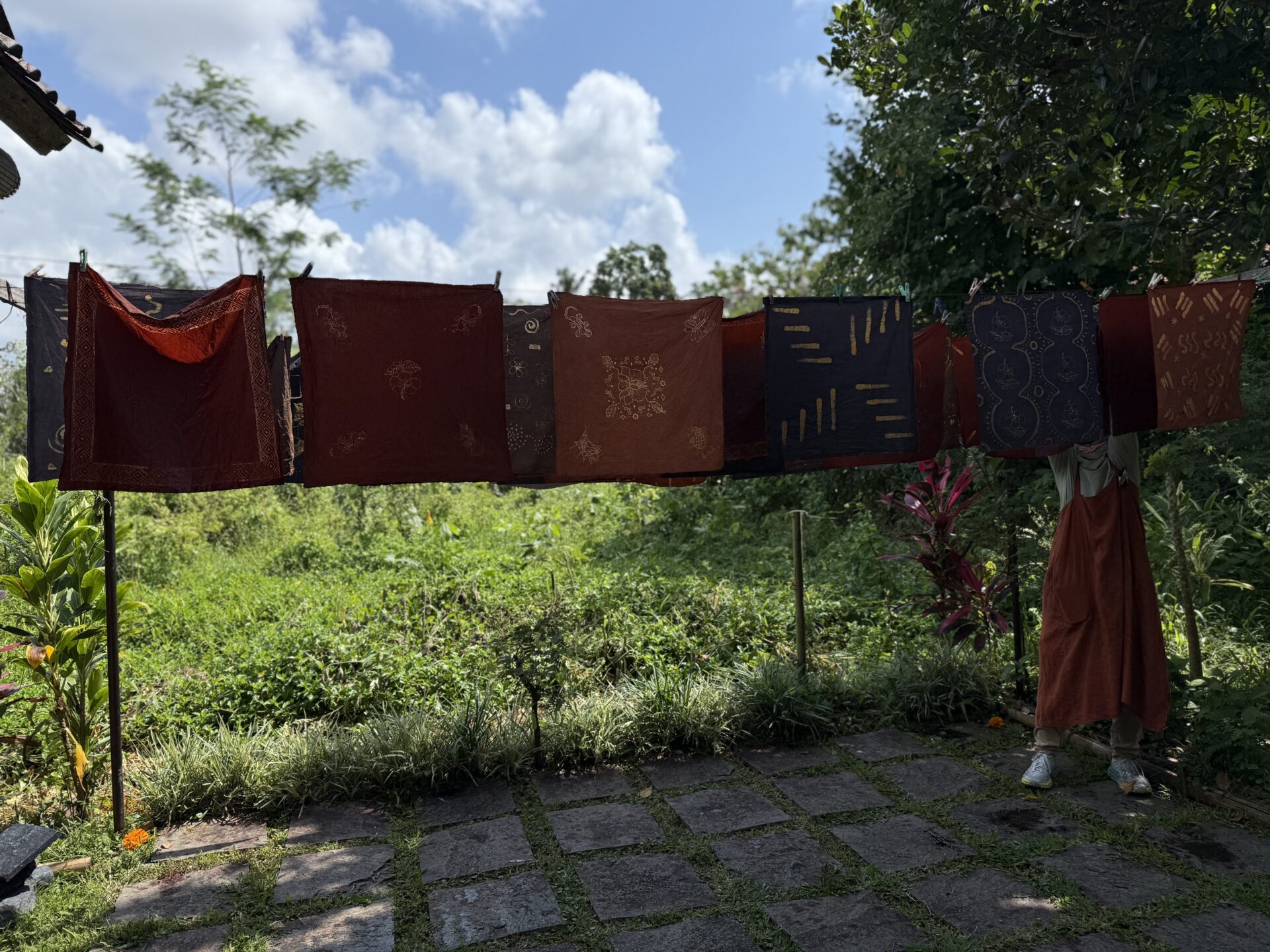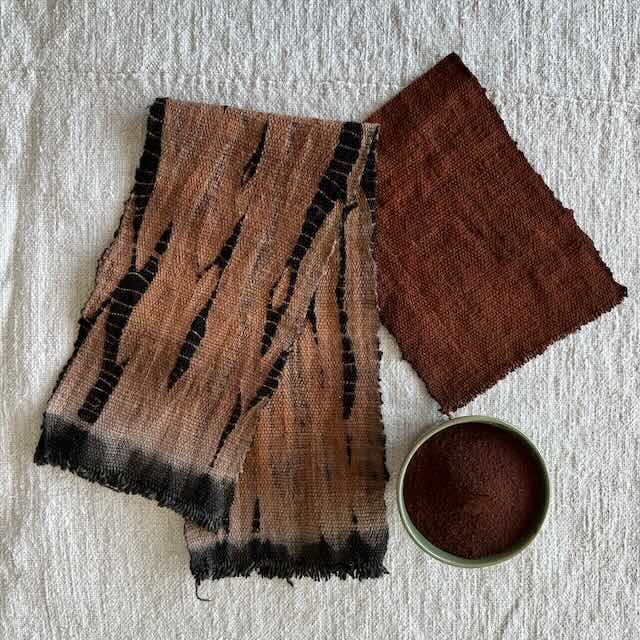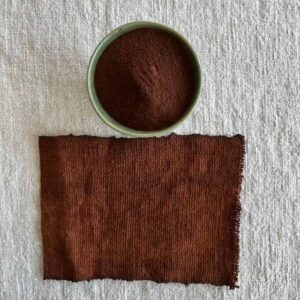
Pictured here is our drying line from our recent tour to The Threads of Life Bali. The black pieces are Ceriops overdyed in Indigo.
Today, we’re taking a look at Ceriops Tagal, a “red” tannin from Indonesia, and a color that is rich in history and traditional use. We are excited to present it to you again as it was one of our favorite dyes to work with while we were at The Threads of Life Bali. At Botanical Colors, we recognize that the mangrove species is threatened due to widespread clearing of mangrove forests for timber, fish farming and other coastal activities. Ceriops Tagal is a product derived from tree bark that would otherwise be discarded. It is harvested and produced under conservation guidelines from the Forest Stewardship Council and provides income for remote villages. Indonesia is home to some of the largest mangrove forests in the world, and the Indonesian government recently instituted mangrove management regulations, which require community participation. According to the World Bank, the economics of restoring mangrove forests is attractive in protecting against flooding and improving ecosystems for fish and aquatic wildlife. These are early efforts, and much more needs to be done, but Indonesia recognizes that protecting its mangrove forests is critical in carbon capture and is embarking on environmental rehabilitation projects and paying villagers to participate in planting and finding additional uses for mangrove fruits and other products.
There are controlled mangrove ecosystems that have Forest Stewardship Council (FSC) certification for environmental management and protection. It is from these mangroves that we obtain our dye. The tree is harvested under FSC guidelines. Additionally, the bark is removed and considered a by-product. The bark is distributed to local villagers who boil the it into an extract. The dye is from our friends at Threads of Life in Ubud, Bali.
Please note that the instructions for traditional use include a 30 day period to age the dye to develop its deepest colors. It may be possible to use it sooner, but we have not experimented with this.
Ceriops is considered precious and the dyestuff is not normally thrown away after a single dye session. Rather, the dye is first mixed and allowed to age for a month. It is then reboiled and strained for dyeing. After dyeing, the dye liquid is returned to the ceriops vat and saved to be used again and again until the dye bath is depleted. It is through multiple dips that the distinctive rich red brown color is developed on textiles. Ceriops may be dipped at room temperature or used in a heated dye bath. Exposure to sunlight changes the color to a darker brown, and overdyeing with iron or indigo creates additional shades.
Skill level: Good for an adventurous beginner or intermediate dyer. You should be familiar with scouring fabric, using iron as a post-bath, and indigo dipping.
The inspiration for this post comes from some samples created during Aboubakar Fofana’s Mineral Mud Dyeing workshop in Seattle in 2022. We used several different tannins to create different backgrounds for mud mark-making. Kentaro Kojima dyed the shibori sample on finimugu fabric from Mali.
Ceriops Tagal – the basic sequence

Pictured here is a piece of Malian finimugu that has been dipped in Ceriops Tagal several times. It gets darker and richer with each dip.
Prepare the Ceriops Tagal dye using the instructions from Threads of Life. It takes about 30 days for the color to develop, but some dyers have been able to work with the dye after about 3 weeks with good results. We have not done any of these shorter duration experiments.
Start with 3 pieces of cotton, each approximately the size of a fat eighth (9×22 inches). If you wish to use finimugu, purchase 2 yards for this test. Cut the two yards of finimugu into 3 equal sized strips, secure the raw edges, and scour.
Scour cotton fabric, using our scour recipe
Prepare your Ceriops Tagal bath using the aged Ceriops Tagal. Carefully dip and wring excess dye back into the Ceriops Tagal container. Hang to dry out of direct sunlight. The dips are short – probably about a minute each – and you can dip as many times as you wish. There is a fair amount of washout from the dyestuff, so dip darker than what you want the final color to be. You’ll have 3 pieces of fabric dyed with Ceriops. Save one as the base color, tie the next one for shibori, and dip the last one into indigo to achieve some beautiful dark shades.
We like to prepare it fairly strong and we do not dilute it with additional water for dipping. After dipping and airing, we return the dye to its container to dip another time. The dye can be used many times until it is exhausted and yielding pale shades.
Ceriops Tagal with Shibori Effects using Iron

Pictured here are from left to right: Ceriops Tagal a medium shade (lighter than the small swatch), then shibori tied and dipped in an iron solution. The small swatch is multiple dips of ceriops tagal.
Here we took one of the Ceriops Tagal dyed fabrics, pleated it lengthwise, bound it tightly with string and then soaked it in water for 30 minutes. After soaking, we immersed it in an iron bath using about 2 grams of iron powder per 100 ml of water. Once the Ceriops Tagal turned dark (this only took a few minutes), we rinsed the sample well, and allowed it to almost dry completely before we unwrapped it and opened it up. This prevents the iron from seeping into the resisted areas of the design.
Overdyeing Ceriops Tagal with Indigo
The indigo vat created an amazing color on Ceriops-dyed finimugu. In my head, I was envisioning a very dark near-black with the combination of a warm brown and an indigo vat. Instead, I got a very, very dark port wine shade as the red of the ceriops really bloomed in the indigo vat. I used a 1-2-3 Fructose vat with Vibrant Valley Indigo paste and dipped it and oxidized it 3 times.

Notes:
- All of these colors were dyed first, with indigo being the last step in the process. This is the reverse of what we normally do in our studio but it makes for some beautiful colors! You can try either sequence to see if one method works better for you.
- Rinse after the final indigo dip and air dry away from direct sunlight.
- Keep the Ceriops bath covered and it seems to stay stable for a long time. We have a bath that is almost 2 years old and still going strong.


